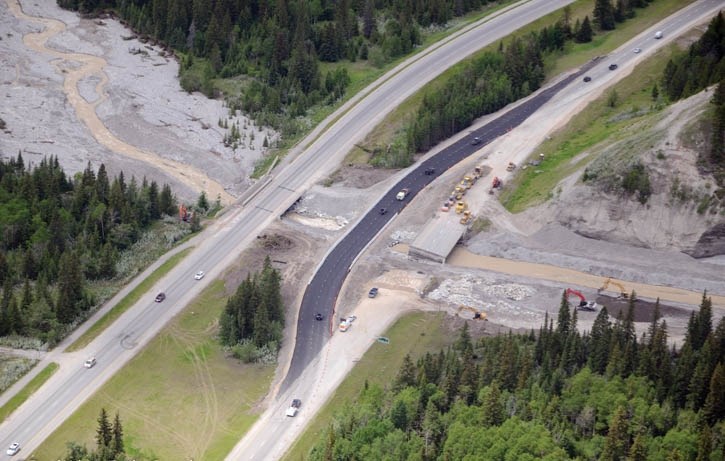Federal Environment Minister Peter Kent was in Banff National Park last week to check out the flood damage – and the federal government says it will commit the necessary money to rebuild.
While flood damage is known in the frontcountry, Parks Canada officials are still assessing the extent of the damage in the backcountry as raging torrents and mudslides destroyed washed away bridges and trails.
“We’re still in the assessment phase and it will be a while before we get a true sense of the costs,” said Sean Nardella, a Parks Canada spokesman. “The eastern part of the park is dealing with a lot of infrastructure damage.”
Minister Kent and Parks Canada CEO Alan Latourelle toured the area last Thursday (June 27) to look at the extensive flood damage and meet with members of the tourism industry and Town of Banff officials.
Fixing the damaged infrastructure on the Trans-Canada Highway remains the top priority, particularly at Carrot Creek, where raging waters completely destroyed a two-lane bridge. The highway has since been temporarily re-routed.
There’s also a commitment to get the Legacy Trail between Banff and Canmore, popular with local riders as well as tourists, completely fixed as soon as possible.
Wild Rose MP Blake Richards said the feds are committed to rebuilding the damaged infrastructure, in the frontcountry as well as in the backcounty, to make sure Banff National Park remains a world-class tourism spot.
But, he says, it won’t be able to happen overnight because the damage is extensive.
“The important thing for everyone to know is there’s the ability to access the funds necessary to rebuild. We absolutely intend to make sure everything is reconstructed as it needs to be,” said Richards.
“We’ve made a commitment to make sure rebuilding happens, whether it’s access roads or the Legacy Trail. There’s obviously been a good start, such as getting the Trans-Canada Highway open.”
The Lake Minnewanka region, a popular spot for strolling, picnicking, day hiking and commercial boat tours, is now open. Access is by way of the upper section of the loop to Lake Minnewanka, Two Jack Lake and Johnson Lake.
Commercial boat tours are running, but at press time private boats and scuba divers were banned as Lake Minnewanka continues to experience high water levels since the torrential downpours.
Many trails and picnic areas are open, including Johnson Lake, Two Jack Lake and Minnewanka day use areas, C-Level Cirque Trail, Upper Bankhead picnic area, Cascade Fire Road for the first five kilometres only and Stewart Canyon.
The Johnson Lake Trail is also now open, though the far end of the lake near the dam has been washed out and hikers need to be prepared to get a little wet.
There are, however, still restrictions in place to protect public safety.
The lower section of the Minnewanka Loop Road remains closed due to road washout at the gravel pit and overflow campground area, and Cascade Ponds remain off limits due to the need to assess flood damage.
Restrictions also apply to the Lake Minnewanka spillway and dam. Water is being released through the spillway and a boom has been put in place to protect the spillway from debris and provide a buffer between boats and the dam.
Pedestrians are not allowed on the dam and motorists and cyclists are not permitted to stop on the dam unless yielding to traffic – this will help keep traffic moving and decrease congestion on the dam.
“It’s fenced around both sides of the spillway,” said Nardella. “We don’t want people there.”
As for the backcountry, there are some official closures in place due to dangerous bridges, but in other cases bridges may have washed away and hikers and horse riders can choose to stay dry or get wet.
Parks Canada officials say stream crossings may be dangerous, noting some streams and rivers are deeper and swifter than usual, and hazards may be difficult to see in murky water.
“We’re recommending people check the trail conditions on our website when planning their trip,” said Nardella. “We’re trying to give people as much information as we can, and let them make the decision on their own.”
Banff Mayor Karen Sorensen, who met with Kent, Latourelle and Richards, said she has been impressed with the work that has been done so far, including getting the highway open in time for the busy Canada Day holiday weekend.
“We did express concern towards visitation this summer and the importance of having the well used park facilities available just as soon as possible,” she said.
“It was a very positive meeting and certainly I feel very comfortable that Parks Canada is absolutely committed to providing what’s needed to bring Banff National Park back up to the standard it was before the flooding.”




